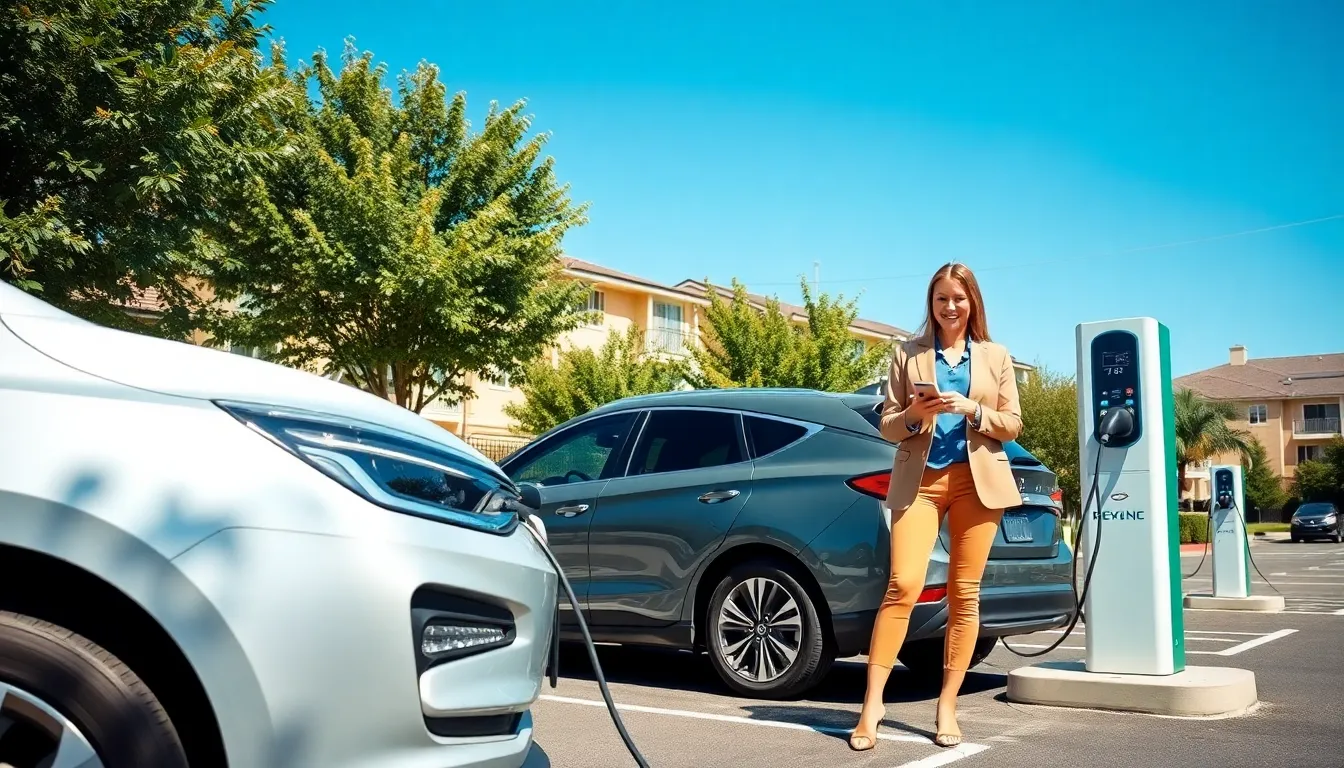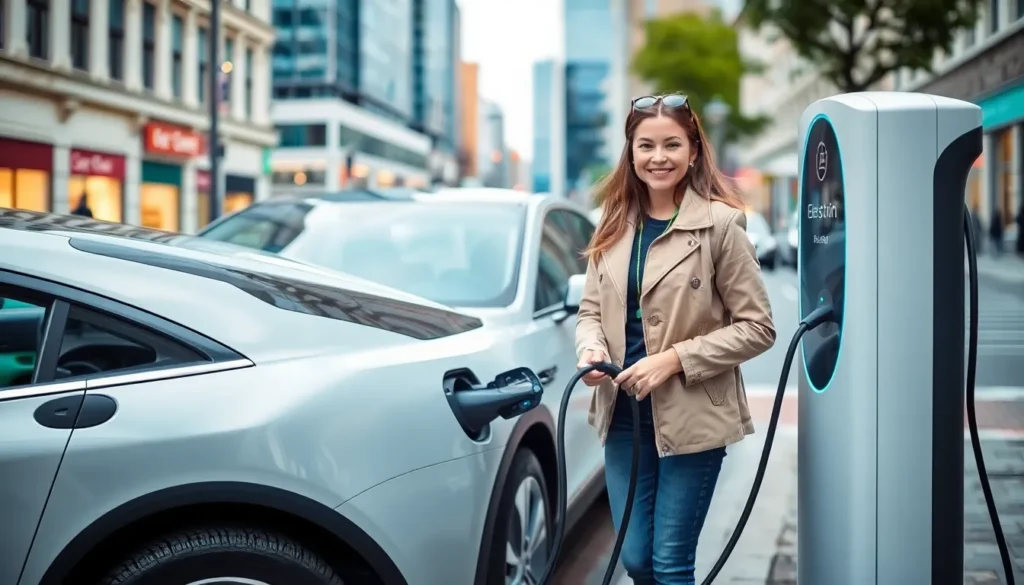Electric vehicles are zooming into the spotlight, and with them comes the need for efficient charging solutions. Think about it: no one wants to be that person stranded at a charging station, staring longingly at their smartphone while their EV takes its sweet time to recharge. Thankfully, the world of EV charging is evolving faster than you can say “range anxiety.”
From ultra-fast chargers that can juice up a battery in minutes to smart home charging stations that make recharging as easy as plugging in your phone, the options are endless. As the demand for electric vehicles skyrockets, understanding the ins and outs of EV charging has never been more crucial. Buckle up as we dive into the electrifying world of charging solutions that’ll keep your ride powered and your adventures on the road.
Table of Contents
ToggleOverview of EV Charging
Electric vehicle (EV) charging has evolved rapidly to accommodate the needs of modern drivers. Various charging options exist, each designed to enhance convenience and efficiency. Level 1 chargers utilize standard household outlets, providing a simple way to charge EVs overnight, though charging times can vary widely.
Level 2 chargers offer a faster solution, typically found in public charging stations and at homes equipped for EV use. These chargers significantly reduce the time required for a full charge, making them ideal for daily commutes. Another advanced option is DC fast charging, which allows for rapid charging, often within 30 minutes or less for a substantial range. These chargers are becoming increasingly common along highways, addressing long-distance travel concerns.
Numerous manufacturers produce charging equipment, catering to diverse vehicle models. Compatibility with various EV makes remains essential, so some models may require adapters. Smart charging stations are gaining popularity, allowing users to control charging sessions via smartphone apps. These innovations help optimize charging costs during off-peak hours, which can lead to significant savings.
Different regions provide distinct charging infrastructure, from urban centers with numerous charging stations to rural areas with limited access. Local governments and private companies increasingly invest in expanding these networks to facilitate EV adoption. Understanding the nuances of EV charging technology and infrastructure supports drivers in making informed decisions, reducing range anxiety, and ensuring a seamless EV experience.
Types of EV Charging Stations

Understanding the different types of EV charging stations is essential for maximizing convenience and efficiency. Each type offers unique features suited for various charging needs.
Level 1 Charging
Level 1 charging utilizes standard 120-volt household outlets. This method provides a simple solution for residential charging. Typically, it delivers about 4 to 5 miles of range per hour. Many EV owners use Level 1 chargers overnight, making it convenient for home use. While the charging speed is slower, it fits well for drivers with minimal daily ranges. Level 1 charging often requires little to no additional equipment, simplifying the charging process for most households.
Level 2 Charging
Level 2 charging stations operate at 240 volts, significantly increasing charging speeds. Most public charging stations and many home installations utilize Level 2 chargers. These chargers can provide 10 to 60 miles of range per hour, making them suitable for daily commutes. Businesses often install Level 2 chargers to attract EV drivers, promoting eco-friendly practices. Users can find these stations in parking lots, shopping centers, and workplaces. The versatility and speed of Level 2 charging accommodate diverse driving patterns effectively.
DC Fast Charging
DC fast charging stations offer rapid charging capabilities, crucial for long-distance travel. These stations typically provide 60 to 80 miles of range in just 20 to 30 minutes. Designed for quick stops, they help alleviate range anxiety during road trips. Locations often include highway rest areas and major travel routes, ensuring easy access when needed. Compatibility varies among EV models, so drivers should check their vehicle’s compatibility before using these chargers. This efficiency makes DC fast charging a valuable component of the overall EV infrastructure.
Benefits of EV Charging
Electric vehicle charging presents numerous advantages that enhance the overall ownership experience. These benefits impact environmental sustainability, cost savings, and user convenience.
Environmental Impact
Electric vehicles contribute significantly to reducing greenhouse gas emissions. Charging EVs with renewable energy sources diminishes reliance on fossil fuels, empowering users to participate in the green revolution. Studies indicate that EVs produce up to 50% fewer emissions over their lifetime compared to traditional internal combustion engine vehicles. Furthermore, incorporating advanced charging solutions, such as smart grids, can optimize energy usage and minimize waste. Choosing renewable energy options for EV charging actively promotes cleaner air, positively affecting public health.
Cost Efficiency
Charging an electric vehicle often proves more affordable than traditional fueling methods. The average cost to charge an EV at home typically ranges from $5 to $10 for a full charge, while gasoline prices fluctuate and can reach significantly higher costs. EV owners also enjoy various incentives, including tax credits, rebates, and lower maintenance expenses. Recharging at public stations may even provide reduced rates during off-peak hours, resulting in substantial savings over the vehicle’s lifespan. Overall, transitioning to electric vehicles leads to notable long-term financial benefits for users.
Challenges in EV Charging
Electric vehicle (EV) charging faces several challenges that impact user experiences and infrastructure development. Addressing these issues is crucial for widespread adoption of EVs.
Accessibility Issues
Access to charging stations varies greatly across regions. Urban areas tend to have more options compared to rural locations, making it difficult for some EV owners to find convenient charging. According to a report by the U.S. Department of Energy, 60% of charging stations are concentrated in metropolitan areas. Limited infrastructure poses a significant barrier for drivers who rely on public charging. Additionally, the availability of charging stations often does not align with the locations of EV drivers. Lack of access could deter potential EV buyers, underscoring the need for equal distribution of charging resources across all areas.
Charging Time
Charging time remains a crucial factor for EV adoption. While Level 1 chargers provide approximately 4 to 5 miles of range per hour, drivers may seek faster solutions during longer trips. Level 2 chargers, delivering 10 to 60 miles of range per hour, cater to daily use, yet can still take hours for a full charge. DC fast chargers offer a solution, enabling 60 to 80 miles of range in just 20 to 30 minutes. Despite this rapid charging capability, long waiting times at busy charging stations may create frustration for drivers. Establishing a more extensive network of fast chargers can significantly improve the overall charging experience.
Future Trends in EV Charging
Advancements in EV charging technology continue to reshape how users interact with their electric vehicles. The emergence of ultra-fast charging stations allows for significantly reduced wait times. These stations can provide up to 80% charge in just 20 minutes, catering to the increasing demand for quick charging options during road trips.
Next-generation smart charging solutions will prioritize energy efficiency and cost savings. Features like automatic load balancing optimize energy usage during peak periods, lowering expenses for users. Additionally, vehicle-to-grid technology enables EVs to feed energy back into the grid, promoting a more sustainable energy ecosystem.
Wireless charging systems also stand on the horizon as a convenient alternative to traditional methods. These systems eliminate the need for connecting cables, simplifying the charging process, especially in public spaces. Furthermore, smartphone integration in charging stations enhances user experience by facilitating real-time monitoring of charging status and station availability.
Regional variations in charging infrastructure will continue to evolve. Urban areas will likely see a more extensive network of fast chargers, while rural regions might catch up through government incentives and private investments. Such efforts may address accessibility concerns and boost EV adoption in underserved areas.
Vehicle manufacturers are expected to collaborate more closely with charging networks. This collaboration could lead to widespread compatibility, enabling users to charge their vehicles effortlessly at various locations. Enhanced interoperability among different EV models will help foster a seamless charging experience.
Finally, the integration of renewable energy sources in charging stations is vital. Stations powered by solar or wind energy contribute to further reductions in greenhouse gas emissions. As the EV market grows, such innovations will not only support environmental sustainability but also provide users with cost-effective charging solutions.
The future of EV charging is bright as technological advancements and infrastructure improvements pave the way for a more sustainable driving experience. With options like ultra-fast chargers and smart home stations becoming increasingly accessible, drivers can enjoy greater convenience and reduced range anxiety.
As the industry evolves, collaboration among manufacturers and charging networks will enhance compatibility, ensuring that all EV owners can benefit from the latest innovations. The shift towards renewable energy sources further underscores the commitment to environmental health and cost efficiency.
Embracing these changes not only supports individual drivers but also contributes to a greener planet for future generations.






